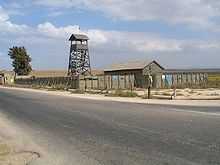Negba
| Negba | |
|---|---|
 | |
 Negba | |
| Coordinates: 31°39′39.24″N 34°40′59.16″E / 31.6609000°N 34.6831000°ECoordinates: 31°39′39.24″N 34°40′59.16″E / 31.6609000°N 34.6831000°E | |
| Region | South-central Israel |
| Affiliation | Kibbutz Movement |
| Founded | 12 July 1939 |
| Founded by | Hashomer Hatzair members |
| Population (2011) | 768[1] |
| Website | www.negba.org.il |
Negba (Hebrew: נֶגְבָּה) is a kibbutz in the northern Negev, Israel. [2]Located near the cities of Kiryat Malakhi and Ashkelon, it falls under the jurisdiction of Yoav Regional Council. The kibbutz has 768 residents[1] and covers an area of 12,000 dunams.
The name of the kibbutz is based on a verse in the Book of Genesis (13:14), where God commands Abraham to cast his eyes and travel throughout the land of Israel, toward the north, south, east and west. The word "negba" means "southward" in Biblical Hebrew.
Battle for Negba, 1948

Kibbutz Negba was founded on July 12, 1939 as part of the tower and stockade enterprise. The first settlers were members of Hashomer Hatzair from Poland. It was the southernmost Jewish settlement in Mandate Palestine.
In the 1948 Arab-Israeli War, the Israeli military engaged in many battles with Egypt. When the Egyptians invaded on 15 May 1948, their forces advanced and captured the police station, Iraq-Suweidan, a Tegart fort named after the nearby Arab village, that controlled the route to the Negev. Aside from the police station, the Egyptians seized Arab villages near the kibbutz, from which they attacked Jewish vehicles traveling on the roads from Ashkelon to Hebron and Jerusalem.
The kibbutz was destroyed in the heavy fighting which went on for three months. On November 9, 1948, after the defeat of the Egyptian army in Operation Yoav, the police station was captured by the Israel Defense Forces.
A memorial to the fallen soldiers was constructed next to the military cemetery: a man and a woman from the kibbutz with a fighting soldier. Next to the memorial statue stands an Egyptian tank. The kibbutz water tower, pockmarked with bullet holes, is a testimony to the fierce battle.[3]
Economy

The kibbutz economy is based on poultry, cattle, orchards, vegetables and two factories. It also has a history museum featuring a reconstructed model of the tower and stockade settlements. Negba, along with Sde Yoav, operate Hamei Yoav, a spa with hot springs and thermo-mineral baths.[4]
Under a new financial arrangement, members who left the kibbutz years ago are now returning as "economically independent members." They live in residences registered in their own name and are partners with equal rights and obligations in the communal element of the kibbutz (education, culture, welfare and infrastructure) but not in the productive assets (agriculture, industrial enterprises and shares in the dairy cooperative Tnuva). [5]
Notable residents
References
External links
- Official website (Hebrew)
| ||||||||||||||
| |||||||||||||||||